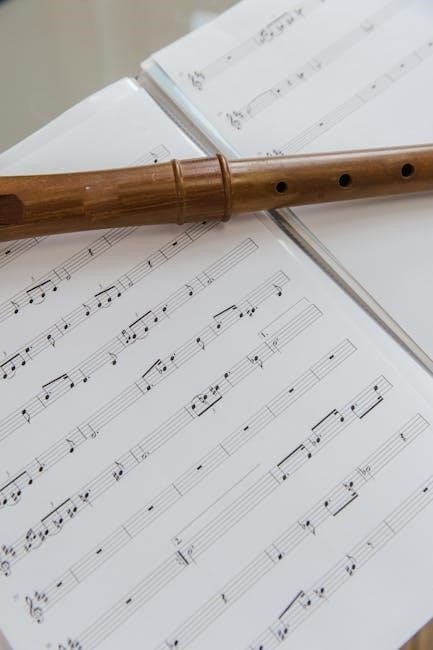Music theory is the foundation for understanding the language of music, providing essential principles and practices that guide composition and performance. It equips musicians with the tools to communicate ideas effectively, enhancing creativity and appreciation for musical structures. Learning music theory empowers artists to craft meaningful compositions and interpret musical works with depth and precision.
1.1 What is Music Theory?
Music theory is the study of the language and practices used in creating music. It examines the building blocks of music, such as notes, scales, rhythm, and harmony, providing a framework for understanding and communicating musical ideas. Music theory is not just a set of rules but a system that helps musicians analyze, compose, and perform music effectively. It encompasses the mechanics of music, offering insights into how melodies, chords, and rhythms work together to create meaningful compositions. By learning music theory, musicians gain the tools to express their creativity and connect with audiences on a deeper level. Whether composing, playing, or appreciating music, theory serves as the foundation for understanding the art form. It is both a science and an art, guiding the creation and interpretation of musical works.
1.2 Importance of Music Theory for Musicians
Music theory is essential for musicians as it provides a universal language and framework for understanding and creating music. It enables musicians to communicate ideas effectively, interpret compositions accurately, and enhance their creative expression. Knowledge of theory helps in composing, improvising, and performing with precision and confidence. It also fosters a deeper appreciation for the emotional and structural elements of music. Whether a beginner or an advanced artist, music theory offers practical tools to refine skills, explore new sounds, and connect with audiences on a profound level. By mastering theory, musicians can unlock their full potential, ensuring their work resonates with clarity and emotion.

The Basics of Music

Music is built on fundamental elements like notes, rhythm, and scales, which form the structure and expression of sound. Understanding these basics is key to musical creation and appreciation.

2.1 Musical Notes and Their Values
Musical notes are the building blocks of music, representing pitches and durations. Notes include clefs, sharps, flats, and naturals, while rests indicate silence. Note values determine how long a pitch is held: whole, half, quarter, eighth, and sixteenth notes, with dots extending durations. Rests mirror note values, creating rhythmic balance. Understanding these elements is crucial for reading sheet music and performing accurately. Stems and flags further specify timing, with flags reducing note value by half. Together, notes and rests form the foundation of rhythm and meter, enabling precise musical expression and interpretation. Grasping these basics allows musicians to communicate musical ideas clearly and effectively.
2.2 Understanding Rhythm and Meter
Rhythm refers to the pattern of sounds and silences in music, while meter is the organization of rhythm into repetitive patterns of strong and weak beats. Time signatures indicate the meter, with the top number showing beats per measure and the bottom number specifying the note value (e.g., 4/4 time means four quarter-note beats). Common time signatures include 4/4 (common time), 3/4 (waltz time), and 2/4 (march time). Syncopation, accents, and tempo variations add complexity to rhythms. Meter provides a structural framework, helping musicians maintain a consistent pulse. Grasping rhythm and meter is essential for playing and composing music effectively, as it underpins the emotional and structural flow of a piece.
Scales are sequences of notes arranged in a specific pattern of whole and half steps, forming the foundation of music. The major scale and natural minor scale are primary scales, with the major scale often associated with happiness and the minor scale with sadness. Modes are variations of scales, each starting on a different degree of the major scale. For example, the Ionian mode is the major scale, while the Dorian mode begins on the second note. Understanding scales and modes helps musicians create melodies, harmonies, and improvisations. They provide a tonal framework and emotional depth, essential for composition and interpreting musical structures. Mastering scales and modes enhances musical expression and appreciation of various genres and styles.

Harmony and Chords
Harmony involves the combination of multiple pitches sounding simultaneously, creating a sense of tension and resolution. Chords are groups of notes played together, forming the backbone of harmonic structure. Common chord types include major, minor, and diminished chords, each with distinct emotional qualities. Understanding harmony and chords is crucial for composing, improvising, and analyzing music effectively.
3.1 Types of Chords and Their Functions
Chords are groups of three or more notes played simultaneously, forming the harmonic foundation of music; The most common types include major, minor, and diminished chords, each with distinct emotional qualities. A major chord consists of a root, major third, and perfect fifth, creating a bright, uplifting sound. In contrast, a minor chord includes a root, minor third, and perfect fifth, often evoking sadness or melancholy. Diminished chords comprise a root, minor third, and diminished fifth, producing tension and instability. Additionally, seventh chords (major, minor, dominant) add complexity by introducing an extra note, enhancing harmonic depth. Each chord type serves specific functions, such as establishing tonality, resolving tension, or creating contrast in musical compositions.
3.2 Chord Progressions and Harmony

Chord progressions are sequences of chords that create harmonic structure and emotional depth in music. They establish tonality, guide listeners through musical phrases, and resolve tension. Common progressions, such as the I-IV-V, are widely used due to their familiarity and emotional resonance. Harmony refers to the combination of multiple pitches sounding simultaneously, with chord progressions serving as its backbone. Effective use of harmony enhances the mood and complexity of a piece, while cadences (concluding chord sequences) provide resolution. Musicians employ chord progressions to evoke specific emotions, creating a dynamic interplay between stability and tension. Understanding harmony and chord progressions is essential for composing and interpreting music, as they form the core of musical expression and storytelling.

Advanced Concepts
Advanced music theory explores complex techniques like intervals, key signatures, and modulation, enhancing musical depth and emotional expression. These concepts refine composition and performance, offering deeper insights into sound structure and artistic interpretation.
4.1 Intervals and Their Emotional Impact
Intervals are the building blocks of music, representing the distance between two pitches. They play a crucial role in creating emotional depth in compositions. Major intervals, such as major thirds and sixths, often evoke feelings of happiness and stability, while minor intervals, like minor thirds and sixths, can convey sadness or melancholy. Dissonant intervals, such as the tritone, create tension, while consonant intervals, like the perfect fifth, bring resolution. Understanding the emotional impact of intervals allows composers to craft melodies and harmonies that resonate with listeners on a deeper level, making music more expressive and impactful. This knowledge is essential for creating emotionally engaging and dynamic musical pieces.
4.2 Key Signatures and Modulation
Key signatures are essential in music theory, defining the tonal center and indicating which notes are sharp or flat throughout a piece; They appear at the beginning of a staff, guiding musicians on the pitch relationships. Modulation is the process of changing the key within a composition, often used to add contrast or emotional depth. It can be achieved through pivot chords, common tones, or gradual shifts in harmony. Understanding key signatures and modulation enhances a musician’s ability to navigate musical structures and create dynamic transitions. These concepts are vital for composers and performers, allowing them to explore various moods and maintain listener engagement. Mastering modulation techniques opens up limitless possibilities for musical expression and innovation.
Practical Applications
Music theory is invaluable for composition, ear training, and sound engineering. It enhances creativity, improves performance, and aids in analyzing musical works, making it essential for musicians and producers.
5.1 Music Theory in Composition
Music theory is a cornerstone of composition, offering composers a structured approach to creating meaningful and impactful music. By understanding scales, modes, and chord progressions, musicians can craft melodies and harmonies that evoke specific emotions. Knowledge of key signatures and intervals allows for the creation of cohesive and balanced compositions. Music theory also provides tools to experiment with rhythm, meter, and form, enabling composers to innovate while maintaining musical integrity. Whether writing for solo instruments or full ensembles, theory serves as a blueprint, guiding the creative process and ensuring that musical ideas are expressed clearly and effectively. This foundation empowers composers to communicate their vision with precision and artistry.
5.2 Ear Training and Music Analysis
Ear training and music analysis are vital skills for musicians, enhancing their ability to interpret and understand musical compositions. Ear training involves recognizing intervals, chords, and rhythms, fostering a deeper connection with music. It improves performance accuracy and composition skills, allowing musicians to transcribe and replicate melodies. Music analysis, on the other hand, involves deconstructing pieces to study their structure, form, and emotional impact. By analyzing harmony, melody, and rhythm, musicians gain insights into a composer’s intent and the cultural context of the work. Both practices strengthen musicality, enabling artists to appreciate and create music with greater depth and nuance, bridging the gap between theory and practical application.
Resources for Learning
Music theory resources include books, online courses, and interactive tools. Popular books like The Complete Idiot’s Guide to Music Theory and websites like Hello Music Theory offer comprehensive learning materials. Apps and ear-training exercises further enhance understanding, providing practical and engaging ways to master musical concepts effectively.
6.1 Recommended Music Theory Books
Several books are highly recommended for mastering music theory. The Complete Idiot’s Guide to Music Theory by Michael Miller is a straightforward guide for beginners. Essential Music Theory by Gordon Green offers a step-by-step approach, suitable for both students and teachers. Harmony and Voice Leading by Aldwell and Schachter is a comprehensive resource for advanced concepts. Additionally, Music Theory for Dummies provides an engaging and accessible introduction. These books cover fundamental topics like notes, scales, chords, and harmony, making them invaluable for musicians seeking to deepen their understanding of music. They are widely regarded as essential tools for learning and applying music theory effectively.

6.2 Online Courses and Tools
Exploring online resources can significantly enhance your music theory learning experience. Websites like Hello Music Theory offer comprehensive lessons, exercises, and ear training tools. Platforms such as Udemy and Coursera provide structured courses on music theory, catering to both beginners and advanced learners. Additionally, tools like MuseScore and Flat allow you to compose and analyze music digitally. Apps such as Music Theory Helper and Ear Training Pro offer interactive exercises to improve your skills. These resources make learning music theory accessible, engaging, and tailored to your pace, ensuring a well-rounded understanding of musical concepts.
Music theory serves as the backbone of music, providing a universal language and framework for understanding, creating, and appreciating musical compositions. By mastering its principles, musicians can unlock creativity, enhance their performance, and deepen their connection to music. Whether you’re a composer, performer, or enthusiast, music theory offers invaluable insights into the structures and emotions behind music. With the wealth of resources available—books, online courses, and interactive tools—learning music theory has never been more accessible. Embrace this knowledge to elevate your musical journey and continue exploring the endless possibilities that music theory has to offer.